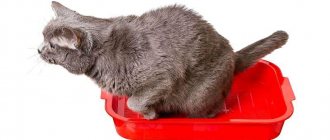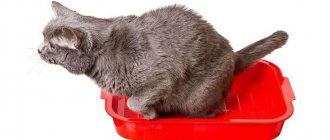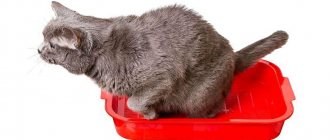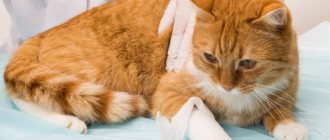The presence of scarlet drops or streaks in the feces is a signal that something is wrong in the cat’s body. This alarming symptom should not be ignored. After all, inaction can lead to severe internal bleeding and death of the pet. Therefore, it is important to understand the reasons for the appearance of blood in feces and in what cases the cat will need emergency hospitalization, and when treatment can be carried out at home.
Why does a cat poop blood?
If the owner regularly cleans the litter box, then without much difficulty and in time he will notice that his cat goes to the toilet with blood. Sometimes other impurities are found in stool that should not be there. For example, mucus, hair or helminth particles.
The most common reasons why this happens:
- Poor nutrition. If a cat is fed food from the human table - cereals, bread, or cheap cat food, this leads to digestive dysfunction. Your pet may become constipated, especially if there is insufficient drinking water. Dry feces damage the intestinal walls, so when your cat poops, blood appears in his stool.
- The pet eats bones. Cats should not be given bones, especially tubular ones, they are very hard and cannot be completely digested. Small sharp pieces injure the intestinal mucosa. As a result, the cat goes to the toilet with a lot of blood.
- A pet has swallowed a foreign body - a wood chip, a fragment of a toothpick, a small piece of plastic. Any small objects with sharp edges that injure the intestinal walls are dangerous.
- Food allergies. When an allergen enters the digestive tract, the body immediately reacts to it. An inflammatory process occurs in the intestines, which leads to disruption of the integrity of the mucous membrane. For this reason, a small amount of blood appears in the stool.
- Blockage of the intestines by hair. This problem is common in long-haired cats. When they lick, they swallow their hairs. Whole lumps accumulate in the stomach. The movement of food becomes difficult, and the pet becomes constipated. It becomes difficult for the cat to poop because the hardened feces are difficult to pass out and damage the rectum.
- Worms. Some types of helminths attach to the intestinal walls. They damage the mucous membrane, so the cat may poop with blood.
- Poisoning by poison. If a cat likes to hunt and goes out for walks, then it cannot be ruled out that she could have eaten a poisoned mouse. Rodent control products cause internal bleeding.
- Colitis. When the colon mucosa becomes inflamed, blood and mucus appear in the stool.
- Tumors. If your cat poops blood, there may be tumors in his digestive tract. They can be benign or malignant. During movement, feces touch the tumor and injure it, so blood is released.
- A side effect from taking certain medications. After treatment with antibiotics, the intestinal microflora is disrupted and dysbiosis develops. This may cause blood to appear in the stool.
- Infectious diseases. Some viruses can cause hemorrhage, but other alarming symptoms should also be present - fever, diarrhea, vomiting, lethargy. If a cat poops loose stool with bloody contents, most likely it is a viral disease. It is important to take him to the veterinary clinic as soon as possible, otherwise he will die from dehydration.
- Often cats poop with blood due to diseases of the internal organs - due to liver problems, stomach ulcers, and pancreatitis.
Little kittens are very curious. During the game, they strive to stick their nose everywhere, so they can get into trouble. Potential dangers for them include small objects on the floor and open packages of detergents or cleaning products.
An angry cat may accidentally knock over the bottle and step its paw into a puddle. Further actions are known - the pet will begin to lick itself and get poisoned.
In most cases, if a cat poops blood, the responsibility lies with the pet owner. It is important to ensure that liquid and bulk disinfectants and laundry detergents are kept out of reach.
Warning signs and symptoms
When cleaning up the pet's potty, the owner may discover that there are several drops of blood on the feces, or that the entire mass of feces is colored reddish. Let us note right away that this is not normal, and such a signal indicates that the animal needs increased observation and attention from humans.
If blood was detected in the stool of a furry pet once, the symptom did not recur again, and the general condition of the animal is assessed as good (that is, the pet is cheerful, cheerful, eats, actively responds to affection), there is no need to worry. Most likely, there was a one-time injury to the animal’s rectum (for example, the mucous membrane could have been scratched by a sharp piece of undigested food or a small foreign object that came out naturally).
The general condition of the cat is an indicator of health
If blood appears in the stool again and again, you need to find out the reason for its appearance immediately. In a situation where bloody spots in the animal’s feces are accompanied by such manifestations as lethargy or lethargy of the pet, diarrhea or constipation, refusal to eat, increased or decreased body temperature (the norm for an adult cat is within 38-39 degrees), you need to take the pet to the clinic immediately.
The severity of the problem at the initial stage can be assessed by the owner himself. You need to make an appointment at the veterinary clinic on the same day if your cat has the following problems:
- The bleeding is profuse (not streaks or droplets, but whole puddles).
- Blood flows from the anus even when not having a bowel movement.
- The animal screams on the potty, showing pain.
- The cat is vomiting.
If the cat wants to go to the toilet, but cannot, the problem requires the intervention of a doctor.
It is not at all necessary (and even impossible) that all of these symptoms will appear simultaneously. The manifestation of at least one of them, together with the blood that appears in the tray, is enough to show the pet to a qualified veterinarian. It is worth remembering that bleeding from the anus can cause the death of a cat quite quickly!
Important! If the listed symptoms are observed not in an adult animal, but in a kitten, you need to act very quickly. Due to the kitten’s fragile body and shaky immunity, the signs mentioned above can become fatal.
Apathy and refusal to eat are the first alarming symptoms
Description of blood in stool depending on the cause
If the owner of a cat discovers that he has started pooping blood, do not immediately panic. The unusual color of stool does not always indicate the presence of red blood cells. The color of the stool may change due to the vegetables your pet has eaten. For example, after eating beets, feces become reddish.
If the cat went to the toilet a lot and bloody clots or scarlet drops are clearly visible in the stool, most likely there are pathologies of the lower intestines. In this case, blood is released that has not been digested. It retains its original appearance. This picture is observed with damage to the colon, rectum or anus.
The problem can be difficult to detect for a person without knowledge of medicine or veterinary medicine. For example, if a cat poops black feces, the color indicates the presence of digested blood. This means that bleeding has opened in the stomach, duodenum or small intestine. In this case, the stool often has a specific smell.
Attention! Black feces can also happen for another reason - if the cat has eaten activated charcoal. The pet could find a tablet on the floor and, out of curiosity, feast on it.
What to do before visiting a doctor
If a cat goes to the toilet with blood for the first time, this is a signal that something is wrong in its body. A consultation with a veterinarian is necessary, but if it is not possible to go to the clinic on the same day, you should take the following actions:
- Observe the condition of the pet. New symptoms may soon appear and will need to be reported to your doctor.
- Carry out deworming. It is advisable to buy a drug that acts on different types of helminths. After 10 days, treatment must be repeated.
- Clear the intestines of hairballs. A special paste will help with this. It is given daily, squeezing 4-5 cm out of a tube. Some cats eat it just like that, while others mix it into their food.
- Change your diet. When a cat poops blood, the first thing you need to do is change his diet. It is advisable to buy holistic food and make sure your pet drinks enough water.
If your cat frequently poops blood or has other alarming symptoms, the problem cannot be ignored. The situation may worsen sharply, and then it will be much more difficult to help the pet.
Additional symptoms
If your cat poops blood, but other accompanying symptoms also appear, you should immediately contact a veterinarian.
Additional signs include the following:
- when defecating, the cat meows, which indicates pain;
- eats poorly or refuses food altogether;
- the pet develops apathy towards everything, he refuses active games;
- body temperature rises;
- the cat urinates frequently;
- weight decreases sharply;
- the pet drinks a lot and often;
- vomiting appears.
Any of these signs is a real stress for the cat, and if it hurts to poop, it only makes the situation worse.
When to seek help from a veterinarian
Emergency help is needed if the cat has severe bleeding. Other symptoms indicate this:
- black vomit;
- lethargy;
- dyspnea;
- loss of consciousness.
If such clinical signs appear, you must contact a veterinarian immediately, otherwise the cat will die. To at least slightly reduce blood loss, ice wrapped in a bag is placed on the pet’s stomach. The cat is taken to the clinic with its head down, this will help prevent hypoxia.
You cannot put off a visit to the veterinarian when a small kitten goes to the toilet with blood. Ignoring an alarming symptom can lead to the death of the baby. After all, at an early age, any ailment is dangerous - kittens develop rapidly infectious and parasitic diseases.
It is worth scheduling a visit to the veterinarian if your cat is pooping blood and has other signs of poor health:
- oppression, reluctance to play;
- loss of appetite;
- mucous or foamy inclusions in stool;
- pain during defecation - when the cat defecates, it begins to meow and arch its back;
- the animal poops irregularly, diarrhea alternates with constipation;
- sometimes there is vomiting;
- if blood appears in the cat’s stool while taking medications.
Prevention
To prevent the formation of blood in your cat’s feces, it is enough to follow simple rules: provide the correct diet, keep chemicals, poisons and rodent poisons away, and also maintain your pet’s personal hygiene.
First, don’t feed the cat:
- any food from the “human” table,
- pork,
- tomatoes and eggplants,
- foods with a lot of seasonings,
- cereals.
Everything fatty, salty and fried will only harm your pet. Your cat's momentary joy can lead to serious and undesirable consequences in the future, including the appearance of blood in her stool.
Secondly, ensure the hygiene of the animal. It is recommended to accustom your cat to washing its paws and brushing its teeth from an early age. Teeth brushing should be done at least 2 times a week, and paws should be washed after each visit to the street.
So, blood in a cat's stool is a deviation from the norm. It is impossible to independently determine the cause of this condition, so you should not hesitate to contact a professional veterinarian in Moscow. Remember that in many cases your pet’s future health depends on your reaction!
How to accurately diagnose the disease
Only a veterinarian can identify the exact reason why a cat is bleeding profusely. The animal owner’s task is to help the specialist collect anamnesis. During the consultation you will have to answer the following questions:
- what does a pet eat?
- does he go outside?
- whether there are poisonous plants or other substances hazardous to health in the house that the cat could reach.
The veterinarian will ask how often your pet poops with blood in it and if there are any other warning signs. For example, constipation, diarrhea, poor appetite, depression. During the examination, the cat's temperature is taken.
To establish the exact cause of blood in the stool, additional research will be needed:
- analysis of stool, urine and blood (general, allergen and biochemical);
- Ultrasound of internal organs;
- X-ray of the intestine;
- colonoscopy;
- If tumors are detected, a biopsy will have to be done.
How is the treatment carried out?
The treatment regimen for a cat that shits blood is developed individually, taking into account the cause of this symptom. When the test results are received, the veterinarian will prescribe medications and diet.
In some cases, surgery may be necessary. Cats with severe internal bleeding are treated in a hospital setting. In other cases, therapy takes place at home.
Effective medications
Since blood in a cat’s feces can appear for various reasons, the treatment is different in each case. List of drugs that are used for various pathologies:
- helminthic infestation - Drontal, Stronghold, Pirantel;
- problems with the liver or pancreas - Pancreatin;
- colitis – Enterol, Subtilis;
- allergies – Tavegil;
- infectious diseases – Gamavit, Fosprenil, Aminovit;
- bacterial infections – Enterofuril, Furazolidone;
- dysbacteriosis – Bifidumbacterin, Linex;
- hemostatic drugs - Etamzilat or Vikasol.
If an adult animal or kitten poops blood due to rat poison poisoning, then treatment should be started immediately. It includes gastric lavage and taking sorbents such as Enterosgel. In case of severe dehydration, the cat is treated with Regidron.
If the pet cannot drink, then the water balance is restored using droppers.
Traditional treatment
Folk remedies can only be used if the cat poops blood due to constipation. Vaseline oil is usually used to loosen stools. It is not absorbed in the upper intestines, but moves through it unchanged, lubricates the intestinal walls and softens the stool.
If your cat is often constipated, you need to look for the cause. Folk remedies give a short-term effect, but do not solve the problem.
The right approach to nutrition
During treatment, it is important to change the cat's diet. The main goal of the diet is to reduce the load on the digestive organs. Veterinarians recommend switching your pet to ready-made hypoallergenic holistic or super-premium food.
Bread, bones, fatty meat and processed foods should be excluded from the diet of a cat that shits blood. For constipation, you can add a little vegetable oil to the food. It is advisable to include fermented milk products in the daily menu - classic yogurt, kefir or yogurt.
Surgical intervention
The operation is indicated if:
- polyps or other neoplasms were discovered in the gastrointestinal tract;
- the pet has swallowed a foreign object;
- the cat cannot poop due to intestinal obstruction;
- internal bleeding began.
What to do if your cat has blood in his stool
The appearance of blood and mucus in a cat’s stool indicates serious problems that require urgent consultation with a veterinarian.
First aid before contacting a veterinarian
Before examining the animal by a specialist, it is necessary to provide pre-medical assistance to avoid criticality of the condition. Among the necessary actions it is worth noting:
- Timely deworming of your pet. You can use any broad-spectrum anthelmintic drugs. Such products are freely available in veterinary pharmacies and pet stores (for example, Febtal, Kanikvantel).
- You can try to clear the animal's intestines of hairballs. Furry animals especially suffer from this. For this purpose, special feed or nutritional supplements are used.
- You need to make sure that water for the cat is in an accessible place.
- It is necessary to control the amount of dry food your cat eats.
Important! If the bleeding does not disappear, then urgent assistance from a specialist and a full examination of the animal will be required.
Diagnosis of the disease and treatment
Diagnostic measures begin with a detailed interview with the owner. The pet is also examined. Then the veterinarian prescribes a series of tests:
- general analysis of urine and blood in the laboratory;
- scatological examination of stool;
- performing ultrasound diagnostics of the abdominal and pelvic organs;
- analysis of excrement for the presence of parasites.
After diagnostic measures have been carried out, treatment is prescribed based on the results obtained. The veterinarian may prescribe the following procedures:
- cleansing and disinfecting enemas;
- taking enzyme preparations that normalize digestion;
- taking antibiotics that fight pathogenic intestinal microflora;
- if necessary, IVs may be prescribed;
- the detected tumor is excised surgically.
If parasites are found in an adult animal or a kitten, anthelmintic drugs are prescribed.
The cat is treated as prescribed by the veterinarian. But besides this, she needs to drink plenty of fluids to maintain water balance and remove toxins from the body.
Important! If the bleeding was caused by excessive consumption of dry food, the cat's diet should be reconsidered.
Preventive actions
The appearance of bloody inclusions in your pet’s stool can be prevented by following these recommendations:
- feed the cat high-quality food, do not give it prohibited foods and treats;
- do not leave small objects on the floor that the cat could swallow;
- worm your pet regularly;
- adhere to the routine vaccination schedule;
- ensure that the cat has constant access to clean drinking water;
- Brush the coat 2 times a week;
- do not let the animal go for a walk unattended;
- Store powder and disinfectants out of reach;
- For any alarming symptoms, seek veterinary help.
There are many reasons why cats poop blood – from dysbacteriosis and allergies to oncology. In any case, do not put off visiting the veterinarian. After all, timely diagnosis of diseases is the key to successful treatment.











